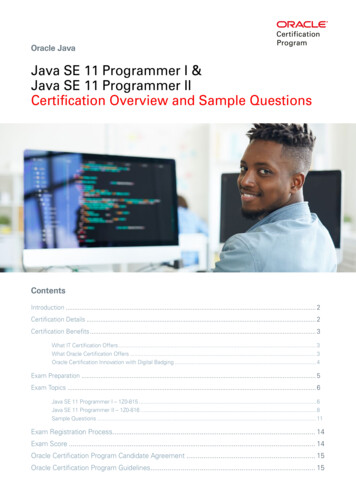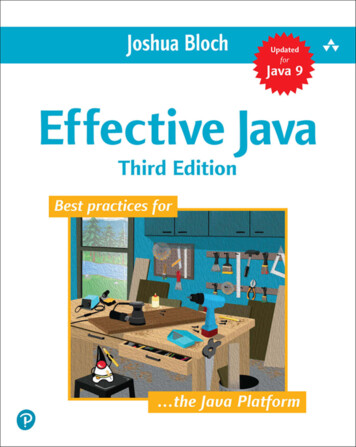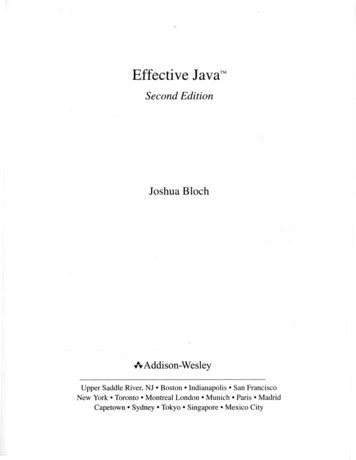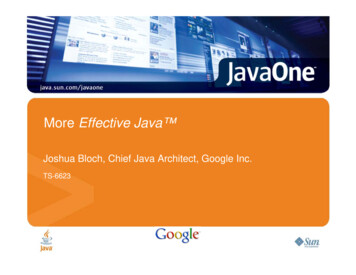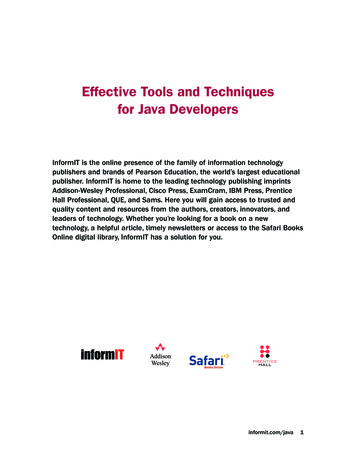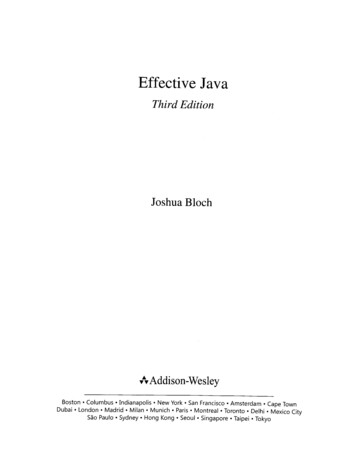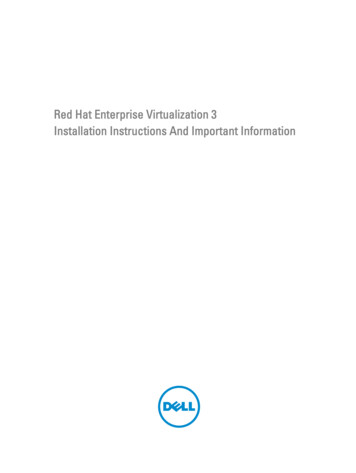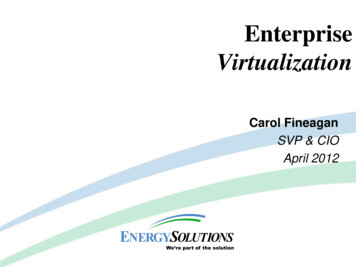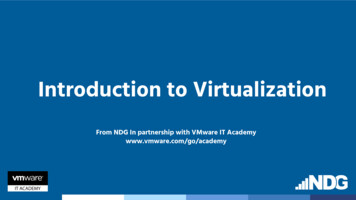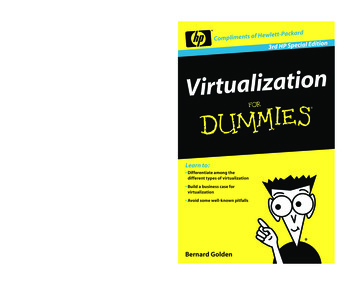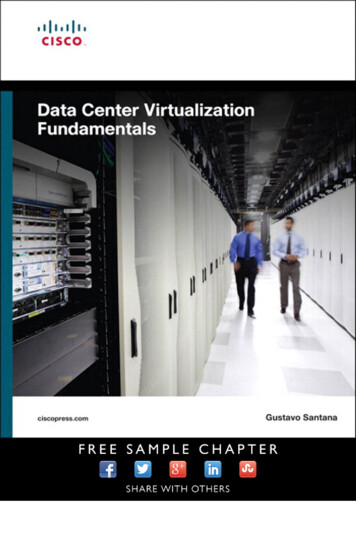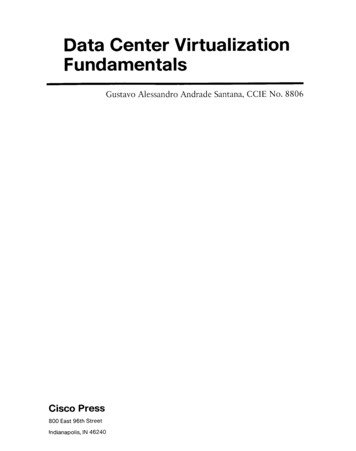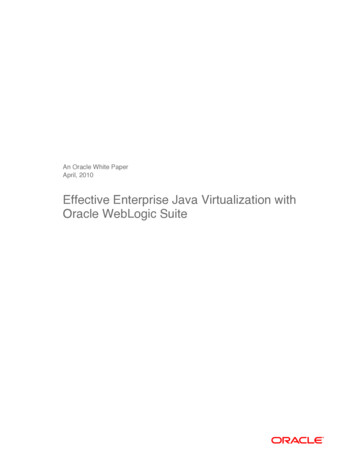
Transcription
An Oracle White PaperApril, 2010Effective Enterprise Java Virtualization withOracle WebLogic Suite
“Oracle WebLogic Server on Oracle JRockit Virtual Edition means you don't have to make a tradeoff between the efficiency ofvirtualization and the performance of dedicated hardware. Oracle WebLogic Server on Oracle JRockit Virtual Edition runningon Oracle VM delivers both -- along with unbelievable simplicity and security.”- Adam Messinger, Vice President OracleIntroductionIncreased operating costs, inefficient hardware utilization and rapidly expanding datacenters have made virtualization the most compelling IT technology in years.Virtualization for the desktop and the server environment have evolved in the past yearsto finally deliver on its promise to lower operating costs and achieve better utilization ofhardware. While virtualization has solved a multitude of problems, it is still difficult todeploy and operationalize complex application made up multiple tiers and components.Furthermore, virtualization is now moving into the commodity stage and the focus ofvirtualizing the operating system will change to be more directly targeted at virtualizingapplications in order to reap the next level of benefits associated with virtualization. Toaccomplish this, organizations are evaluating and implementing Platform as a Service(PaaS) initiatives as a means of achieving greater cost efficiencies in the data center.Making this transition can be difficult as virtualization at this level has to date not beenwell supported by application and infrastructure providers. With the Sun acquisitionunder its belt, Oracle finds itself in a unique situation of being able to offer integratedcapabilities throughout the entire technology stack that provide a complete integratedoperationalized environment particularly well suited to offering PaaS, taking the promiseof cost savings through virtualization to the next level.Through innovations at the operational and runtime levels, Oracle WebLogic Suiteprovides an industry unique infrastructure enabling effective virtualization of Java EEdeployments. This technical paper explores in detail the technology behind a newvirtualized deployment paradigm for Java EE applications. Described below is not onlythe technology behind these advances, but also the benefits to the operationalenvironment.What is Virtualization?Virtualization is the process of abstracting hardware resources, such as CPU, memory, storage,and network interfaces, such that multiple operating systems and applications can share thesame hardware resources while maintaining strict isolation. The hardware runs virtualizationsoftware (e.g. a hypervisor) that enables the installation of multiple operating systems, eachcapable of running simultaneously and independently, in its own secure environment.1
In a virtualized environment, each isolated partition runs an operating system and application.Each partition behaves as if it were a dedicated physical computer with its own [virtualized]CPU, network interfaces, storage, and operating system. Figure 1 shows multiple applicationsdeployed in a hypervisor based virtualized environment.FIGURE 1: APPLICATIONS RUNNING IN A HYPERVISOR BASED VIRTUALIZED ENVIRONMENTThe goal(s) of virtualization for IT vary, but generally fall into one or more of the followingcategories:1.Consolidate hardware to increase application density; save on cooling, rack space.2.Increase utilization of provisioned hardware.3.Accelerate provisioning of new applications and infrastructures.4.Better manage dynamic fault tolerance and re-configuration of deployed systems.5.Provide isolation of operating systems and applications on the same hardware.6.The ability to run both legacy and new software on the same hardware.Middleware Virtualization ChallengesWhile most middleware can function perfectly fine in a virtualized environment, applicationspecific management challenges such as the ability to effectively manage and easily deploycomplex applications materialize. Since most middleware applications are comprised of multipletiers (UI, computational, caching, persistence etc.) the rollout of new deployments can bedifficult as there are few facilities within traditional virtualization infrastructure to guaranteeconsistency and correctness of deployments. To make matters worse, migrations from differentenvironments such as development, test and production are further complicated when dealingwith virtualized environments. To address these concerns and challenges, WebLogic Suite addsadditional capabilities to effectively manage virtualized deployments as well as provide for anoptimized environment specifically targeted at Java EE applications.2
Three key technologies help solve the operational complexity problem of deploying virtualizedenvironments: Oracle VM, Oracle Virtual Assembly Builder and Oracle WebLogic Server onOracle JRockit Virtual Edition.Oracle Fusion Middleware, such as SOA Suite and WebCenter based applications, making useof WebLogic Suite for their runtime can take advantage of these new virtualization capabilities.All applications certified on WebLogic Suite are certified to execute on Oracle VM as well asuse capabilities available through Oracle Virtual Assembly Builder. For SOA based applications,in particular, which tend to be complex, the notion of being able to create virtual appliances andform simple to deploy assemblies is compelling as this simplifies and accelerates deployment,reducing the risk of configuration errors as the application moves through the naturalenvironment life cycle (development, test and production).Moving from a physical to a virtual (P2V) environment is at first glance simple; create virtualimages of the physical deployments. Inevitably, this results in image sprawl creatingmaintenance overhead as each of the images must be patched at the OS and application layerscreating for unanticipated costs. Below, we will see how software assemblies address this issuethrough re-use of images across applications.Java middleware is already virtualized through the Java virtual machine. Executing thisenvironment on a hypervisor introduces undesirable application latencies. For custom Java EEapplications, an optimized runtime environment is now available through Oracle WebLogicServer on Oracle JRockit Virtual Edition, allows for significantly improved performance overtraditional virtualization environments.Software AssembliesAn assembly is a collection of interrelated software appliances that are automatically configuredupon deployment. Assemblies are typically deployed onto a set of virtualized hardwareresources to ensure high levels of hardware utilization and efficiency.While assemblies are simply a collection of virtual appliances with defined interconnects,assemblies must adhere to a set of base principles in order to be useful in a productionenvironment; including:1.Allow for the composition of virtual appliances as well as external systems.2.Externalize configuration in the form of metadata that can easily be modified withoutpotentially damaging the assembly itself. For example, virtual IP addresses virtualLANs and disk volumes.3.Define version (and patch) level dependencies between constituent appliances.4.Allow for the definition of boot order as well as dynamic startup parameters.5.Provide management mechanisms that fit into existing management infrastructure thatallows for metadata definition, deployment, oversight and diagnostics.In addition to being comprised of virtual appliances, assemblies can also contain externalreferences to systems that are not contained in the assembly. This is necessary to includeinfrastructure such as databases or JCA endpoints that cannot or should not be included in anassembly.3
“We have tested the Oracle WebLogic Server on Oracle JRockit Virtual Edition in the context of the CERN Open labpartnership and we have found impressive benefits for our organization. This solution significantly simplifies the maintenanceof our middleware solutions and provides a cost-effective scalability on demand as it runs without a guest Operating System.Overall, Oracle WebLogic Server on Oracle JRockit Virtual Edition will allow us to respond faster to the request of our users”- - Carlos Garcia Fernandez, Computer Scientist, CERNThe Oracle Virtual Assembly Builder infrastructure and associated tooling adheres strictly to theabove principles providing a comprehensive Java EE virtualization infrastructure uniquelyoffered by Oracle.The Power of AssembliesThe notion of being able to create pre-built assemblies for deployment is extremely powerfuland has a number of advantages that help drive down operational costs and complexity. Theseinclude: The ability to easily replicate assemblies in production, even allowing for variations of theassembly without adding complexity. Reduce risk of configuration errors as assemblies are moved between development, test andproduction environments. Replicated environments allow for high level of standardization and consistency acrossapplication infrastructures, allowing for simple implementation of best practices. Accelerates deployment of new infrastructures and applications.Oracle Virtual Assembly BuilderA simple way of composing more complex assemblies of virtual appliances is required.Specifically what is needed is tooling that allows for the composition of virtual appliances aswell as end point mapping of externalized systems and other larger non virtual appliance basedsystems such as databases and ERP systems.Included in Oracle WebLogic Server Enterprise Edition and Oracle WebLogic Suite is OracleVirtual Assembly Builder, a set of tooling comprised of an intuitive visual environment, as wellas command line interface, allowing administrators and deployers to constitute completeassemblies encompassing all the components and systems that make up a potentially complexapplication structure or infrastructure. Figure 2 shows a ‘screen shot’ of Oracle VirtualAssembly Builder Studio.4
FIGURE 2: ORACLE VIRTUAL ASSEMBLY BUILDER STUDIOOracle Virtual Assembly Builder provides the following capabilities: The ability to browse catalogs of existing assemblies and virtual appliances allowing for simplere-use of existing infrastructure. The main assembly editor that allows for declarative composition of new assemblies based onexisting appliances and external systems. As depicted in Figure 7, the assembly editor sectionshows entry and protocol endpoints that can easily be connected between appliances usingdrag-and-drop. The properties inspector that shows the editable properties (metadata) of assemblycomponents. Automated packaging of complex multi-tier applications into a collection of self-containedsoftware appliances and assemblies. Analysis of application configurations and inter-dependencies. Creation of templatized definitions of complete configuration which allows for simpledeployment. One-step deployment of entire multi-tier application onto virtualized resources.The assembly creation and deployment process, depicted in Figure 3, is straight forwardconsisting of four simple steps. First, in the introspection phase, the necessary metadata andconfiguration information is captured from a physical deployment for all components that will5
make up the appliances within the assembly. Subsequently the relationships are establishedamong the appliances and external resources. The packaging process simply creates thedeployment artifacts necessary for the assembly that is relevant to the particular virtualizationplatform (e.g. virtual images). Finally, the deploy phase deploys the assembly into yourdevelopment, test or production environment.FIGURE 3: ASSEMBLY CREATION AND DEPLOYMENT PROCESSFollowing the above process yields a number of benefits: There will no longer be a need to manually create new deployment environments. Once thevirtualized pool of resources are in place, assemblies can easily be deployed without requiringadditional configuration or setup. Over time, a catalog of virtual appliances and resources are established that will allow forefficient reuse of work. Oracle Virtual Assembly builder provides a convenient P2V processThe command line facility of Oracle Virtual Assembly Builder allows for complete end-to-endautomation of the virtual appliance, assembly creation, configuration, provisioning anddeployment process.Oracle Virtual Assembly Builder is positioned to become Oracle’s preferred mechanism fordeploying applications and infrastructure onto virtualized resources.External ResourcesWhen creating assemblies it will often be necessary to include immovable systems within theassembly. However, it may not be desirable to package up the external system and to include inthe assembly package. For this reason, Oracle Virtual Assembly Builder allows thas the ability tocreate and configure virtual appliances as well as introspect external systems (i.e. databases) thatwill not be packaged as a part of the virtual appliance. The external systems can then easily bereferenced as part of the assembly just as if it were another virtual appliance creating consistencyand simplicity in the configuration and deployment process.Oracle Virtual MachineA key building block for any virtualized deployment is a sound underlying hypervisor as well asnecessary management capabilities providing provisioning, cloning, VM migration and highavailability. Oracle Virtual Machine (Oracle VM) provides not only the hypervisor layer, but alsothe management capability as the foundation for virtualization for all of Oracle FusionMiddleware, including Oracle WebLogic Server on Oracle JRockit Virtual.6
Optimizing Java EE VirtualizationModern virtualization technology has solved a multitude of problems. However, performancecontinues to be an area of concern for some; particularly for Java based server side applications.There is some penalty on overall application performance of applications deployed on ahypervisor. In part this is attributed to I/O limitations in the hypervisor layer as well as CPUtime slicing across potentially multiple guest operating systems and applications.With the introduction of Oracle WebLogic Server on Oracle JRockit Virtual Edition, Oracleprovides a novel way to deploy Java based middleware in a virtualized environment by allowingJava EE applications to be deployed in a virtualized environment without paying theperformance and scalability penalties typically associated with running on a hypervisor.With advances in the virtual machine layer of the Oracle JRockit virtual machine, OracleWebLogic server can now be run directly on the hypervisor eliminating the need for a guestoperating system, thereby eliminating the added overhead of running unnecessary layers of guestand host operating systems that consume valuable resources. The end result is a more secure,higher performing and better scalable virtualized deployment offering comparable performanceto traditional physical deployments.Oracle JRockit Virtual EditionIn order to understand Oracle WebLogic Server on Oracle JRockit Virtual Edition, it isnecessary to understand the foundation that makes optimization of Java EE deploymentspossible. Oracle JRockit provides this foundation and its technical characteristics are describedbelow.Oracle JRockit Java Virtual Machine is the highest performing server side Java Virtual Machineand is the preferred Java Virtual Machine of customers running Oracle WebLogic Server on x86and SPARC based hardware. JRockit comes bundled with Oracle WebLogic Server andprovides excellent real time capabilities as well as tooling for diagnosing application latenciesand memory leaks.A key design goal of Oracle WebLogic Server on Oracle JRockit Virtual Edition is to provide anoptimized execution environment targeted specifically at virtualized deployments. OracleWebLogic Server interacts directly with the underlying Java Virtual Machine for all its needs(CPU, disk I/O, networking, etc). For this reason, the guest operating system required fordeployment on most hypervisors becomes superfluous for all Java applications that do notmake use of operating system resources directly.With JRockit Virtual Edition, the otherwise necessary operating system services that wouldtypically be required by the JRockit Java Virtual Machine have been implemented in JRockitVirtual Edition itself. JRockit Virtual Edition provides the necessary operating systemcapabilities, for the JRockit Virtual Machine to run directly on the hypervisor. One can think ofthis as the base services required by the most basic application (CPU, disk I/O, networking) andthe Java runtime environment (JRE) providing the rest. These services have been implementedin the lightest weight possible, eliminating all overhead otherwise imposed by a guest operatingsystem and its associated multitude of processes. Figure 4 shows a conceptual illustration ofJRockit Virtual Edition hosting a Java application. Figure 4 shows the comparison of a7
traditional virtualized Java solution compared to the simpler solution using JRockit VirtualEdition.FIGURE 4: TRADITIONAL VIRTUALIZATION STACK VS. JROCKIT VIRTUAL EDITION STACKJRockit Virtual Machine AdvantagesBy allowing JRockit to execute directly on the underlying hypervisor, the full potential of thevirtualized hardware is completely dedicated to serve the Java Virtual Machine versus the guestoperating system. The end result is better utilization of hardware, resulting in betterperformance and better scalability. Subsequently, this allows for more processing to take placeon the exact same hardware. By freeing up resources consumed by the guest operating system itis also possible to execute additional Oracle WebLogic server instances on the same hardwarecompared to a traditional virtualization environment necessitating a guest operating system.Other advantages include: 12The effort of configuring1, tuning and patching the operating system is eliminated by theinclusion of this functionality in the JRockit Virtual Edition. This results in a significantoperational cost savings. Configuration of JRockit Virtual Edition is surprisingly simple,requiring only a single XML configuration file where only the basic parameters concerningCPU, Network, Virtual Disk2 and Virtual Memory are specified. Figure 5 depicts a typicalJRockit Virtual Edition configuration file. Note the simplicity with which the Java VM isconfigured.A typical Operating System contains thousands of configuration files.The Virtual Disk specific is a NFS mount point.8
?xml version "1.0" encoding "UTF-8"? jrockitve-imagetool-configxmlns:xsi amespaceSchemaLocation "jrockitve-imagetool-config.xsd"version "5.1" jrockitve-config memory "256 MB" cpus "1" storage disks disk id "root" size "180 MB"/ /disks mounts mount mount-point / /mount-point disk root /disk /mount /mounts /storage vm-name default-vm /vm-name java-arguments HelloWorld /java-arguments network nics nic type "bridged"/ /nics /network /jrockitve-config jrockitve-binary-url file:././jrockitve.bin /jrockitve-binaryurl /jrockitve-imagetool-config FIGURE 5: SAMPLE JROCKIT VIRTUAL EDITION CONFIGURATION FILE The cost and effort of making an operating system secure should not be overlooked. Asignificant amount of an administrators time is spent consuming and evaluating varioussecurity bulletins to understand the impact on their respective operational environments. Byeliminating the guest operating system, the largest source of security concern has beeneliminated. Thereby, allowing operational staff to eliminate this work item from their dailyactivities. Administrators can focus more on application rather than operating system administration. Application patching becomes even simpler with JRockit Virtual Edition by providingsupport for offline configuration and patching, something that is not possible on traditionaloperating systems including Linux, UNIX and Windows. Booting a JRockit Virtual Machine instance occurs in seconds compared to minutes with atraditional virtualization system involving a guest operating system, significantly acceleratingprovisioning. This allows for a more dynamic deployment environment capable of rapidlyadapting to user demands.Oracle WebLogic Server on Oracle JRockit Virtual EditionOracle WebLogic Server on Oracle JRockit Virtual Edition provides a complete and optimizedvirtualized runtime environment for Java EE applications. Figure 6 provides a completeillustration of the Oracle WebLogic Server on Oracle JRockit Virtual Edition execution stack.9
FIGURE 6: ORACLE WEBLOGIC SERVER ON ORACLE JROCKIT VIRTUAL EDITION EXECUTION STACKAlthough a new deployment paradigm, users familiar with WebLogic Server applicationdevelopment, deployment and administration will be able to make use of existing knowledge,tools and techniques. The application development and deployment process remains consistentwith the traditional non-virtualized deployment paradigm. Virtual appliances can easily becreated based on a WebLogic Server domain. These domains can be pre-populated withapplications already deployed, or can be generic with applications deployed to WebLogic Serveronce it is up and running in the virtualized environment.As for administration, WebLogic Server administration tools such as WebLogic Scripting Tool(WLST) scripts, the WebLogic Server Management Console and weblogic.Deployer can still beused to administer and manage Oracle WebLogic Server on Oracle JRockit Virtual Edition.There have been no runtime changes to the WebLogic Server code base ensuring a low risktransition to Oracle WebLogic Server on Oracle JRockit Virtual Edition. In addition,monitoring and diagnostic tools such as AD4J and JRockit Mission Control continue tofunction as they did before in a non-virtualized deployment environment.Oracle WebLogic Server on Oracle JRockit Virtual Edition provides a simple command linetool (wlsveimagetool.jar) that allows for the creation of WebLogic Server based virtualappliances. The functionality by the Image Tool can be scripted using shell scripts and [Apache]Ant allowing for end-to-end automation of the virtual appliance creation and provisioningprocess.Once a WebLogic Server based virtual appliance has been created, the appliance can simply bedeployed on the physical servers using Oracle VM. Maintenance of the virtual appliance can beperformed using standard WebLogic management tools for configuration, deployment andlifecycle management.Performance10
Although virtualization has been a key technology for reducing hardware cost, virtualization hasimposed such overhead making it unviable for production deployment. With Oracle WebLogicServer on Oracle JRockit Virtual Edition, Oracle has overcome this performance hurdle forJava EE based applications.Performance benchmarks of Oracle WebLogic Server on Oracle JRockit Virtual Edition showsa significant performance improvement over traditional virtualized deployments. Table 1describes the configuration of a performance test scenario using identical hardware. The dataillustrates a significant 30% improvement in overall throughput of the application compared tothe traditional para-virtualized deployment, while achieving 83% performance of a physicaldeployment. This translates into higher application density which is one of the goals ofvirtualization that contributes to an overall cost reduction. It is also important to note that theDom0 (domain 0) CPU utilization shows a 26% reduction versus the traditional virtualizedenvironment. The latter indicates that it is possible to execute additional instances of OracleWebLogic Server on Oracle JRockit Virtual Edition without performance penalty as a result ofexceeding the Dom0 CPU.PHYSICALORACLEGUEST O/S PARAO/SVM / WLSVEVIRTUALIZEDWEBLOGIC SERVER10.3.1 GA10.3.1 GA10.3.1 GACLOCK SPEED2.93 GHz2.93 GHz2.93 ONS / SEC335.94306.59249.09--28.40%39.51%MEMORY SPEED (MHZ)JROCKITDOM0 CPU UTIL.TABLE 1: SAMPLE PERFORMANCE COMPARISON DATAAdditional performance metrics are in the process of being published.When Not to Use Oracle WebLogic Server on Oracle JRockit Virtual EditionAs most Java EE applications do not make explicit OS calls, Oracle WebLogic Server on OracleJRockit Virtual Edition becomes an attractive deployment alternative for virtualizedenvironments. However, there are some restrictions on the applications deployed on top ofOracle WebLogic Server on Oracle JRockit Virtual Edition that need to be understood. Theseinclude: Deployed Java EE applications cannot rely upon ‘System’ operating system calls as these willfail. Applications can not contain native code, since JRockit Virtual Edition is optimized forrunning pure Java applications.11
SummaryOracle WebLogic Server on Oracle JRockit Virtual Edition running directly on Oracle VMraises the bar for virtualized Java EE deployments by creating an optimized server side JavaVirtualization stack. By eliminating the guest operating system, there are several key advantagesthat are realized: Better Hardware Utilization resulting in better overall performance and better scalability ofthe hosted Java EE application. Integration with Oracle Virtual Assembly Builder delivers simplified deployment of entireWebLogic Server domain onto virtualized resources Simple provisioning through Oracle VM infrastructure3. Offline maintenance and patching not available with a traditional guest operating system. Reduced security vulnerabilityOracle WebLogic Server on Oracle JRockit Virtual Edition creates not only a novel runtimeparadigm for Java EE deployments, but also combines this environment with Oracle VirtualAssembly Builder and runtime management and operational tooling into a completevirtualization solution. The end result is virtualization infrastructure optimally suited to reducedeployment and management complexity resulting in increased hardware efficiency andutilization while at the same time drastically reducing operational costs.Enterprise Manager Grid Control support will become available in a future release of WebLogicSuite.312
White Paper TitleApril 2010 Rev A.Author: Erik BergenholtzContributing Authors: Mark PrichardOracle CorporationWorld Headquarters500 Oracle ParkwayRedwood Shores, CA 94065U.S.A.Copyright 2010, Oracle and/or its affiliates. All rights reserved. This document is provided for information purposes only andthe contents hereof are subject to change without notice. This document is not warranted to be error-free, nor subject to any otherwarranties or conditions, whether expressed orally or implied in law, including implied warranties and conditions of merchantability orfitness for a particular purpose. We specifically disclaim any liability with respect to this document and no contractual obligations areformed either directly or indirectly by this document. This document may not be reproduced or transmitted in any form or by anymeans, electronic or mechanical, for any purpose, without our prior written permission.Worldwide Inquiries:Oracle is a registered trademark of Oracle Corporation and/or its affiliates. Other names may be trademarks of their respectivePhone: 1.650.506.7000owners.Fax: 1.650.506.7200oracle.com13
provides an industry unique infrastructure enabling effective virtualization of Java EE deployments. This technical paper explores in detail the technology behind a new virtualized deployment paradigm for Java EE applications. Described below is not only the technology behind these advanc
